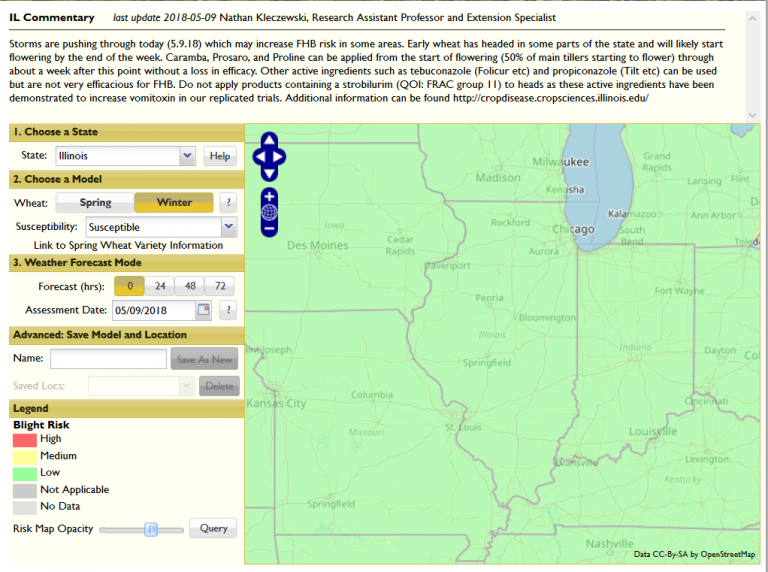One of the hallmarks of the United States Wheat and Barley Scab Initiative was the development of the Fusarium Head Blight Prediction tool (or FHB Risk Tool). This tool represents over 15 years of research conducted by plant pathologists around the country. Several versions of the tool have been made available, and we are constantly working to improve the accuracy, utility, and functionality of the tool. Currently, data indicate that the FHB Risk Tool can accurately predict outbreaks of FHB (>10% index, which typically is associated with elevated vomitoxin and yield loss) roughly 80% of the time. This tool has saved producers millions in application costs and FHB related losses since its launch.
How does it work?
The FHB Risk Tool uses humidity values from the region, captured from the last 15 days to determine the risk of FHB development. The fungi that cause FHB require a certain amount of humidity and warm temperatures to grow, produce spore-bearing structures, and release spores. Most spores are deposited from the atmosphere at night. When spores land on flowering wheat heads, infections are most severe and can result in bleached kernels as well as elevated vomitoxin (DON).
Steps for use:
1) Sign up for updates on the main page. Select Illinois. You can set up alerts for specific fields if needed. However, often the state map is sufficient. Signing up for alerts as well as having at least a site marked will allow you to receive email or text alerts if the location is at elevated risk or I have entered new commentary.
2) The model slowly updates during the morning. It is best to check the model around lunch for the most recent risk prediction. Remember that the tool is only useful for FLOWERING wheat. Plants that have yet to flower are not at risk for FHB.
3) The tool automatically selects susceptible varieties for the risk model. Use the variety resistance values to determine if your variety is considered moderately resistant, moderately susceptible, or susceptible. There are very few truly susceptible varieties still available, and most would fall into the moderately susceptible category. More moderately resistant varieties become available each year. Select the model most appropriate for your variety. If you do not know your resistance level, assume it is moderately susceptible.
4) Use the forecast tool to see the future risk for up to 72 hours. Check the weather forecast to see if there may be additional rain events in the near future, as these may increase risk but not be included in the forecast. Remember that the information you are seeing are generated from data collected the previous day. If it is raining at lunch when you are looking at the tool, that rain event will not be included in the risk assessment until the next day.
5) You have about a 6 day window, maybe 3 days more if temperatures are cool, to make a fungicide application of Prosaro, Caramba, or Proline for FHB suppression. Read the label and follow the guidelines regarding volume and nozzle selection. Use the tool to help guide your fungicide decision.
6) Remember that the model can under-predict risk if temperatures are cool, but the weather is very wet. It may be best to select the susceptible model if you have a moderately susceptible variety and conditions are cool and wet.
How should you use it?
You can use the tool in two ways 1) to determine If to make a spray; 2) to determine to not make a spray. In my opinion, #2 is more practical, as most producers have acquired product and are planning on a spray at flowering for scab. It is much easier to decide not to take out the sprayer or order a custom application than to attempt to make an application at the last minute. Regardless, the tool helps producers make informed fungicide applications as it related to FHB. Are you at low risk for FHB, foliar diseases are low, and you planted a variety moderately resistant to FHB? Perhaps that fungicide application and associated cost can be avoided?
Sign up for alerts today and give the tool a try if you have not already done so. It might just save you some money. #wheat


